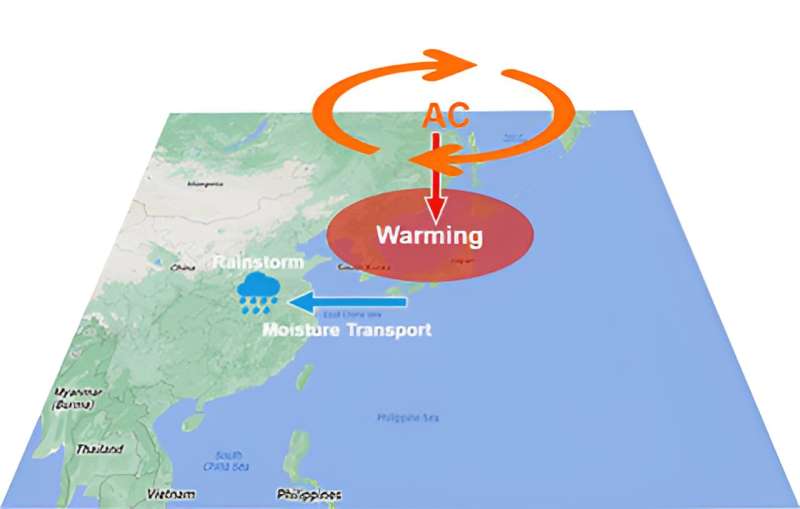This article has been reviewed according to Science X's editorial process and policies. Editors have highlighted the following attributes while ensuring the content's credibility:
fact-checked
trusted source
proofread
Unprecedented anticyclonic anomaly in northeast Asia triggers extreme weather events and prolonged marine heat wave

A study published in Advances in Atmospheric Sciences has revealed the unprecedented nature of an anticyclonic anomaly that occurred over Northeast Asia in July 2021. It not only played a pivotal role in the catastrophic extreme precipitation experienced in Henan Province in central China, but also caused a prolonged and intense marine heat wave in the Japan Sea—the strongest event of its kind in the western North Pacific in the past four decades.
The marine heat wave triggered an unprecedented widespread outbreak of harmful algae in the coastal waters, causing severe damage to the marine ecosystems and a record-breaking loss to Japan's coastal fisheries.
"The anomalous anticyclone event over Northeast Asia in July 2021 was unprecedented in terms of intensity and duration. It remained extremely persistent and robust for an astonishing 10 consecutive days from July 13 to July 22, 2021," said Prof. Lu Riyu from the Institute of Atmospheric Physics (IAP) of the Chinese Academy of Sciences, corresponding author of the study, emphasizing the magnitude and duration of this anomalous anticyclone.
The impact of the persistent heavy rain was widespread, affecting 150 counties and a staggering 147.86 million people, leading to direct economic losses of 1,200.6 billion yuan. On July 20, Zhengzhou, the capital city of Henan province, suffered a tragic loss of life, with a total of 380 casualties.
Previous studies have shown that the unprecedented event was the result of the combined effect of several weather systems. Prof. Lu's team investigated the evolution of the extreme anomalous anticyclone event over Northeast Asia in July 2021, and further explored the significant impact of this anomalous anticyclone on the surface temperatures beneath it.
In this study, they revealed that the anomalous anticyclone led to exceptionally warm sea surface temperatures in the Sea of Japan/East Sea that persisted for an extended period of 30 consecutive days from July 13 to August 11, 2021—long after the weakening or departure of the anticyclone.
Further analysis in the study suggests that two key factors contributed to the longevity of this anomalous anticyclone: a teleconnection pattern over extratropical Eurasia during the first half of its life cycle and the Pacific-Japan teleconnection pattern during the second half.
This study highlights the critical role of extremely anomalous mid-latitude anticyclones in triggering multiple climate catastrophes over different regions. Understanding and monitoring such anomalies are essential for improving our ability to predict and mitigate the impacts of extreme weather events.
More information: Xingyan Zhou et al, The Unprecedented Extreme Anticyclonic Anomaly over Northeast Asia in July 2021 and Its Climatic Impacts, Advances in Atmospheric Sciences (2024). DOI: 10.1007/s00376-023-3026-5
Provided by Chinese Academy of Sciences




















